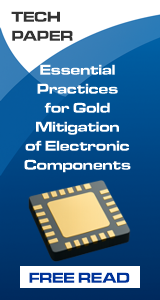|

|
|
|
||||||||
Should Apertures be Home Plate or Inverted Home Plate?
Board Talk
|
||||||||
TranscriptPhil And welcome to Board Talk with Jim Hall and Phil Zarrow of ITM Consulting, the Assembly Brothers. And today we are coming to you from the ITM pub, which is located near the base of Mount Rialto so nobody gets hurt. We're here to talk about electronic assembly, materials, equipment, components, practices, procedures, secret decoder rings and many other things. Jim, what is our question du jour? Jim The question come from S.B. regarding home plate stencil apertures. Should the aperture be home plate or inverted home plate? You know the performance difference between the two types. Which one is better? Well perhaps, Phil, we should define home plate to make sure we all know what we are talking about, an aperture for a rectangular pad, which is not rectangular, but in fact looks like a home plate, it is five-sided, two right angles, and then a pointy side on the other part. A traditional home plate had these apertures oriented so that the pointy section pointed towards the center of the component. They were developed a long time ago to minimize solder beading or mid-chip solder balls. Phil Particularly on ceramic capacitors because they had the metal end caps and the idea by narrowing down to that point, there was less propensity, less solder, to be squeezed underneath the center of the component to form that so-called mid-chip solder ball. It has been pretty traditional as well. But back to the question Jim. Jim Right, and that was developed when capacitors were larger, 12060805. It is probably applicable down to 0603, maybe 0402s. But historically as we got to the ultra miniature parts, 0402 may fit this but definitely 0201s, mid-chip solder balling became the least of our problems, and tombstoning became a much bigger issue. And that is where some people have developed what they call inverted, or reversed, home plate, where they rotate that 180 degrees, so that the pointy part of the aperture is not under the component, but is pointing away from the component. The strategy here was that by minimizing the amount of paste on the outer part of the pad, not underneath the component, when it started to melt it would take time for the solder to flow out from under the part and would and then wet up the vertical end of the chip component. That would minimize the possibility that you would get surface tension forces out of balance, which is the mechanism that creates tombstones. And some people feel that was very successful, other people were not too excited about that. Obviously when you get to 0201s tombstoning is a huge problem and there are many different strategies, starting with proper pad design and modified paste, and finally shoulder profile developed by Dr. Lee of Indium. Once you get to slow down the heating right at the melting point to minimize the possibility that the surface tension forces get out of balance and tip the component up. Which one is better? It depends on why you are using home plate. Are you trying to avoid mid-chip solder balls, or are you trying to avoid tombstoning the ultra-small components. That is why you would use one or the other, in my humble opinion. Phil And by the way, there is a number of papers out there. If you look back through the different proceedings of both SMTAI and APEX you will find a number of papers. You will even see some where, again for the same purposes Jim was discussing for some of the ultra-miniature passives and things like that, there are also experiments with what they call the roundese, which are basically radius edges as opposed to the straight-defined edges. It is like everything else in this industry, for every paper or study done that is pro something you will find something that is "I'm against it!", the actual opposite. So as Jim said, understand why you are doing it in the first place and very carefully read up whatever you can. But Jim gave the basics there, and that is what you want to follow. Do your homework, I guess. Jim One comment, Phil. Realizing that we are old you know whats and that we have been around forever. And there are young people out there who haven't. If you weren't around during the transition from the miniaturization of chip components, to go down to 0402s and 0201s, the tombstoning issues were huge. People who had minimal amount of tombstones, all of a sudden you went to these small parts and you were getting a very, very high percentage of tombstoning. Everybody was running around trying to figure out what was the best solution. And as my brother said, there were many of them proposed and different people had different opinions. But if you weren't there it is difficult to understand the concern of trying to deal with all of these tombstones. Phil Good. Well, hopefully we answered the question in a non-ambiguous way. You just squandered another five minutes listening to Board Talk with Phil and Jim. Just remember, if you can't laugh at yourself, we certainly will. Whatever else you do, don't solder like my brother. Jim And don't solder like my brother. |
||||||||
Comments
|
||||||||
|
|

|




